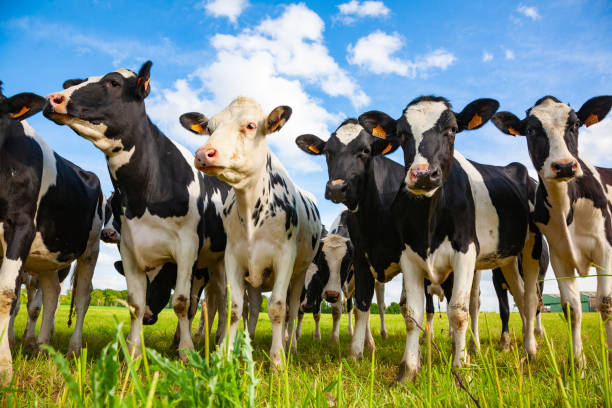Automated Safety
Farm Safety
Farm Management
Automated Safety
Farm Safety
Farm Management
Cattle Behaviour and Handling Techniques
By James Diamond, September 6, 2022
When you learn and employ proper handling techniques when caring for your cattle herd, you will maintain quality standards while minimising animal stress. If the cattle are unduly stressed, it can result in low conception rates, low weight gains, insufficient milk production, and an increase in their susceptibility to disease, among other problems. Understanding cattle behaviour is a component of learning how to manage cattle. In the end, their actions and reactions reveal their emotions at the moment.

Cattle Behaviour
Cattle are huge, swift, and violent animals that become even more so when mistreated or provoked. Stressed and agitated livestock pose a threat to both livestock handlers and themselves. We can make use of several of the cattle’s natural behaviours, including:
- They view humans and dogs as potential predators and have a natural aversion to them.
- They will maintain a predetermined distance from prospective predators, known as the flight distance or flight zone.
- Being herding animals, they will gather in the face of a possible predator rather than scatter.
- Cattle dislike being separated in the pasture or in yards. They are susceptible to being excessively irritated and unpredictable.
- When they detect a potential predator, they will stand and face it directly. This is because their peripheral vision is poor at distinguishing fine details, requiring them to focus on an object by staring at it directly.
- Due to their blind spot, they cannot see an object or person right behind them.
- Males and females in the herd will strive to keep other animals within their 330-degree field of vision. They have the ability to immediately identify threats.
- If cattle freeze in place and refuse to move, it’s possible they’ve detected danger and are pausing to assess the situation.
- There is a hierarchy inside a herd, with some animals dominating the others. This dominance may at times be challenged. For instance, hostility can arise when herds are intermingled, as dominance must be reestablished between the herds.
- When adult bulls are crowded, fights may break out at entrances or in yards.
- In a battle, bulls are uncontrollable. They become incredibly unpredictable and abruptly depart.
- Cows are very protective of their young, making it risky to handle a calf in the company of its mother. Additionally, if a cow is not caring for its calf in the appropriate manner, this may indicate a problem.
- Young bulls, when moved in groups, display a certain amount of fun (pushing and shoving), but as they age they become more violent and territorial.
- When cattle are lethargic, disinterested in grazing, and/or sleeping excessively, they may be unwell and require special treatment.
Effective Handling Methods
Effective handling procedures are essential for safeguarding the safety of livestock handlers and the well-being of cattle. A good safety culture typically results in fewer incidents and accidents, which in turn reduces the costs associated with higher workers’ compensation premiums, loss of efficiency owing to the hiring or retraining of additional staff, and ongoing medical expenses. It is more likely to result in a positive work environment and the retention of skilled employees.
By utilising appropriate handling techniques, animals are less agitated, do not feel threatened, and are less prone to behave aggressively and unexpectedly to livestock workers.
Other advantages of these cattle handling procedures include improved animal welfare, as animals are less likely to damage themselves or other animals, higher production, decreased labour requirements, and less expensive and robust facilities. These strategies can be utilised in situations where an animal can physically move, such as mustering in paddocks, working through yards, or loading trucks:
- Cattle handlers must constantly remain as calm as possible when interacting with agitated cattle in order to prevent additional fight-or-flight responses. The more tranquil they remain, the easier it will be to relax the animals and assist them through their anxiety.
- If the bulls are fighting, the handlers cannot do much without endangering their own safety. To prevent this issue, give each bull a minimum of 6 metres of personal space and avoid crowding bulls in any circumstance.
- Cows are protective of their calves, so caretakers must be cautious when handling calves in their presence.
- Handlers must remain within the cattle’s field of vision so they can see their gestures and hear their commands when attempting to move the animals.
- Utilize equipment and aids such as head bails, branding cradles, and drafting canes.
- Create stockyards and sheds robust enough and of the appropriate size for the cattle being handled.
- Prevent sharp, blind corners and ensure gates are properly positioned.
- Keep facilities in good shape and free of waste.
- Restrain cattle using cattle crushes, head bails, and cradles.
- Maintain non-slippery conditions on yards.
- Avoid fast movements or loud noises. Cattle have about 360-degree peripheral vision. Cattle may be “spooked” by a sudden movement in their rear. Additionally, they have exceptional hearing and can detect sounds that human ears cannot.
- Be patient; never provoke a trapped animal.
- Touch animals gently as opposed to pushing or bumping them.
- Do not yell.
- Always have an escape plan ready when working in close proximity to animals. Alleys and chutes should be broad enough for animals to travel through, but too narrow for them to turn around.
- Age-eligible bulls are quite dangerous. Employ specialised facilities and exercise extreme caution when handling them. Never assume they are tame; never trust them.
- Do not put your arms or legs through the race walls. Do not attempt to move a hazardous bull on foot or alone.
- Keep small children away from locations where animals are handled.
